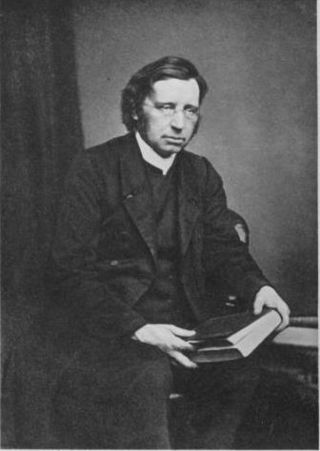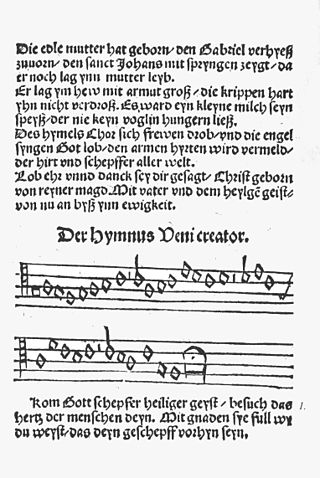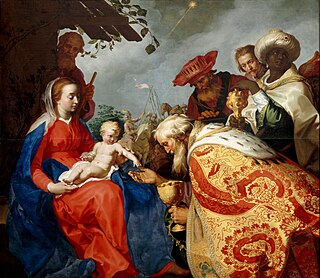Vexilla regis prodeunt is a Latin hymn in long metre by the Christian poet and saint Venantius Fortunatus, Bishop of Poitiers. It takes its title from its incipit.

John Mason Neale was an English Anglican priest, scholar, and hymnwriter. He worked and wrote on a wide range of holy Christian texts, including obscure medieval hymns, both Western and Eastern. Among his most famous hymns is the 1853 Good King Wenceslas, set on Boxing Day. An Anglo-Catholic, Neale's works have found positive reception in high-church Anglicanism and Western Rite Orthodoxy.

Hymns Ancient and Modern is a hymnal in common use within the Church of England, a result of the efforts of the Oxford Movement. The hymnal was first published in 1861. The organization publishing it has now been formed into a charitable trust, Hymns Ancient and Modern Ltd, and as of 2022 it publishes a wide range of hymnals as well as other theological and religious books and magazines, under imprints such as the Canterbury Press and SCM Press.

Edward Caswall, CO, was an Anglican clergyman and hymn writer who converted to Catholicism and became an Oratorian priest. His more notable hymns include: "Alleluia! Alleluia! Let the Holy Anthem Rise"; "Come, Holy Ghost"; and "Ye Sons and Daughters of the Lord".
"Veni Creator Spiritus" is a traditional Christian hymn believed to have been written by Rabanus Maurus, a ninth-century saint, German monk, teacher, and archbishop. When the original Latin text is used, it is normally sung in Gregorian Chant. It has been translated and paraphrased into several languages, and adapted into many musical forms, often as a hymn for Pentecost or for other occasions that focus on the Holy Spirit.

O filii et filiae is a Christian hymn celebrating Easter. It is attributed to Jean Tisserand, a Franciscan friar.

Te lucis ante terminum is an old Latin hymn in long metre. It is the hymn at Compline in the Roman Breviary.
Aurora lucis rutilat is the incipit of an Easter hymn of the Latin rite, first recorded in the Frankish Hymnal tradition and preserved in the Benedictine "New Hymnal" . In the numbering introduced by Gneuss (1968), it is no. 41 of the Old Hymnal, and no. 72 of the New Hymnal. The hymn has 12 strophes of 4 verses each as originally recorded;in modern translations it is often reduced to 11 or fewer strophes. The Old High German interlinear version in Bodleian Junius 25 begins Tagarod leohtes lohazit.

"Te Splendor" is a Roman Catholic hymn dedicated to Saint Michael, the Archangel. The hymn derives its name from the fact that in Latin it begins with the words: Te splendor et virtus Patris. The hymn is found in the Roman Breviary.
"Veni redemptor gentium" is a Latin Advent or Christmas hymn by Ambrose of Milan in iambic tetrameter. The hymn is assigned to the Office of Readings for Advent, from December 17 through December 24, in the Liturgy of the Hours. John Mason Neale and Thomas Helmore saw it as an Evening hymn for the period from Christmas to the eve of Epiphany.

"All Glory, Laud and Honour" is an English translation by the Anglican clergyman John Mason Neale of the Latin hymn "Gloria, laus et honor", which was written by Theodulf of Orléans in 820. It is a Palm Sunday hymn, based on Matthew 21:1–11 and the occasion of Christ's triumphal entry into Jerusalem.

"Komm, Gott Schöpfer, Heiliger Geist" is a Lutheran hymn for Pentecost, with words written by Martin Luther based on the Latin "Veni Creator Spiritus". The hymn in seven stanzas was first published in 1524. Its hymn tunes are Zahn No. 294, derived from the chant of the Latin hymn, and Zahn No. 295, a later transformation of that melody. The number in the current Protestant hymnal Evangelisches Gesangbuch (EG) is 126.

Conditor alme siderum, is a seventh-century Latin hymn used during the Christian liturgical season of Advent. It is also known in English as Creator of the Stars of Night, from a translation by J.M. Neale.

"Christus, der uns selig macht" is a German Lutheran Passion hymn in eight stanzas in German by Michael Weiße, written in 1531 as a translation of the Latin hymn "Patris Sapientia" to an older melody of the Bohemian Brethren.
The Cistercian Hymnal is a compilation of the ancient texts and melodies sung by Cistercian monks and nuns during the Liturgy of the Hours. This collection of hymns influenced the Cistercian Order's identity, since early abbots emphasized the compositions' musical quality. The hymnal developed in the course of the centuries.

"Earth Has Many a Noble City" is a Christian Epiphany hymn originally written by the Roman poet Aurelius Clemens Prudentius and translated by the English clergyman Edward Caswall in 1849.

"Ye Choirs of New Jerusalem" or "Sing, Choirs of New Jerusalem" is an English Easter hymn by Robert Campbell. It is a 19th-century translation of the medieval Chorus novae Ierusalem, attributed to Fulbert of Chartres. The text's primary focus is the Resurrection of Jesus, taking the theme of Jesus as triumphant victor over death and deliverer of the prisoners from Hell.
"Alleluia, dulce carmen" is a medieval Latin hymn sung during the week before Septuagesima as a preparation to the dismissal of the Alleluia.
Audi benigne Conditor is a Latin hymn used during Lent attributed to Gregory the Great, who reigned as pope from the year 590 until the year 604.














